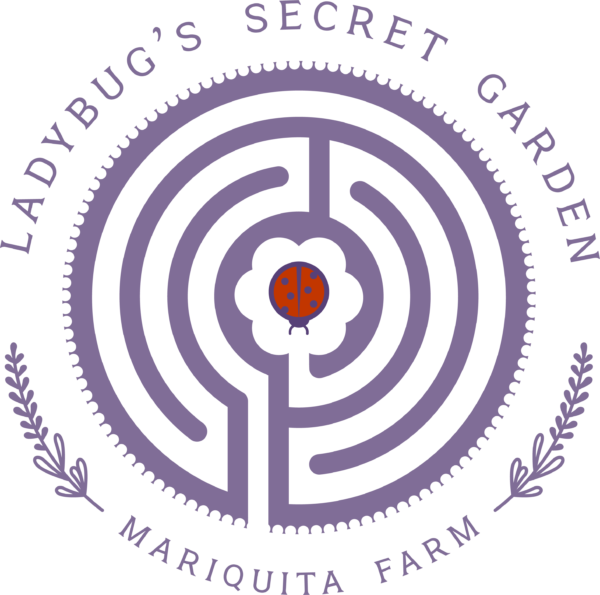Letters From Andy
Ladybug Letters
Your Dollars Can Count Supporting Farms in Your Backyard
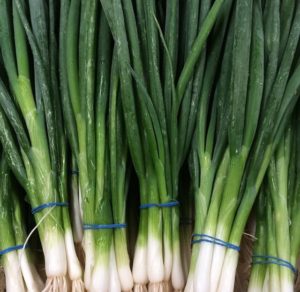
Askelon is a port city along the eastern coast of the Mediterranean Sea. Today Askelon is in Israel, but it’s an ancient city, and people have inhabited the site for at least 8000 years. It’s one of the biggest ports in the Eastern Mediterranean and the root meaning of the name, Askelon, may have something to do with business or mercantile activity. Whatever the name originally meant, the settlement served as a shipping point for onions that were exported by sea. That name of that sea, the Mediterranean, comes from the words “medi,” or “in the middle of” and “Terra” “of the Earth,” or “Terra” —the sea at the middle of the world. Askelon’s aromatic bulbs made for happy customers “all around the world,” and the port city became synonymous with the onion. In fact, our modern word “scallion” comes from Askelon, as does the word “shallot.” Recently we were asked by our friend, Colleen Logan, from Savor the Local based in Carmel, to write a piece on “why people should support local family farms. This week we’re picking scallions for your harvest box. Why should you want to get your onions from a local farm instead of buying a more famous or cheaper brand from “across the sea,” like they did in the good old days?
The food supply is a transnational dynamic these days, as indeed it has been for ages. We need to have the ability to move food around the planet if we’re going to guarantee food security to everybody and keep regional famine at bay. Also, it’s just nice to live in the Northern hemisphere yet be able to enjoy tropical fruits all year long. Food prices in the US are also often cheaper than they otherwise would be, were it not for foreign imports. Farm workers in Ecuador make as much in a day’s labor as a farm worker in the United States makes in an hour, so it’s no surprise that they can ship frozen strawberries from Guayaquil to processors much more cheaply than growers in California can. If produce from far away is not only sometimes more exotic and often cheaper than local produce is, why support local farms? I’m a local farmer; why support me?
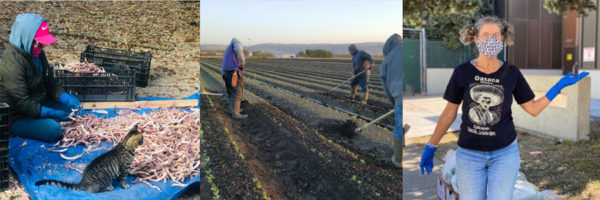 Your local farmer is a neighbor, a member of your community. When you support a local farmer the money you spend on the farmer goes back into our local economy and builds our community. That’s true even when you live in San Francisco or Oakland and the farmer lives in Watsonville. Where does “community” begin and end? When I get on the freeway and listen to “the traffic and weather together every fifteen minutes,” the reports cover all the territory from 17 in the south to Petaluma and 101 in the north – that’s one big bowl of asphalt and concrete spaghetti we all share in common and have to deal with. Some of that traffic comes as local farms and farm workers spend money in your cities and buy your goods and services. It’s good for the community for the money it generates to travel from home to home in circles and keep more locals employed.
Your local farmer is a neighbor, a member of your community. When you support a local farmer the money you spend on the farmer goes back into our local economy and builds our community. That’s true even when you live in San Francisco or Oakland and the farmer lives in Watsonville. Where does “community” begin and end? When I get on the freeway and listen to “the traffic and weather together every fifteen minutes,” the reports cover all the territory from 17 in the south to Petaluma and 101 in the north – that’s one big bowl of asphalt and concrete spaghetti we all share in common and have to deal with. Some of that traffic comes as local farms and farm workers spend money in your cities and buy your goods and services. It’s good for the community for the money it generates to travel from home to home in circles and keep more locals employed.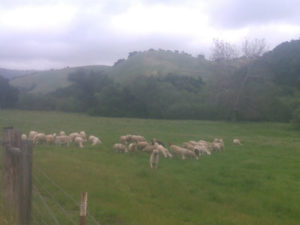 But farmers are more than just neighbors and consumers. The farmers around you are the custodians for the natural resources in your local area. Farmers and ranchers make their living from the soil and water and how they treat those resources directly affects you, whether you buy their produce or not. If you don’t want agricultural chemicals in the water you drink, then support the local organic farms that are producing food without recourse to the noxious chemicals that would contaminate your water or foul your air. If you enjoy the rural character of the hills on the horizon of your community then support the ranchers whose work it is to manage those rangelands. If restaurants and markets in your community make a point of supporting local farmers, ranchers, and fishers, then support them so that they can play their role in creating and maintaining a vital, viable foodshed.
But farmers are more than just neighbors and consumers. The farmers around you are the custodians for the natural resources in your local area. Farmers and ranchers make their living from the soil and water and how they treat those resources directly affects you, whether you buy their produce or not. If you don’t want agricultural chemicals in the water you drink, then support the local organic farms that are producing food without recourse to the noxious chemicals that would contaminate your water or foul your air. If you enjoy the rural character of the hills on the horizon of your community then support the ranchers whose work it is to manage those rangelands. If restaurants and markets in your community make a point of supporting local farmers, ranchers, and fishers, then support them so that they can play their role in creating and maintaining a vital, viable foodshed.- Maybe not every local agricultural producer is doing a good job of caring for the environment that we all share; but support the farms that are good stewards of our environment and encourage them. And supporting local farms is good for the environment because they can have a smaller carbon footprint than larger companies. If you like having cleaner air, then don’t buy food that has to come into the Bay Area on a jet, cargo ship or long haul truck. Put your money where your mouth- and lungs- are. And cleaner air isn’t just about us; we have to breathe the air that blows in from Asia and someone else will have to breathe the smog we create. When there’s less air pollution anywhere in the world everybody wins.
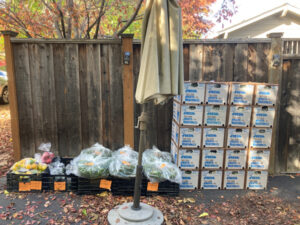 Sometimes local produce costs a bit more than produce purchased in chain stores. Local producers may not use as much energy as distant suppliers in getting their produce to market but they often have significantly higher labor costs or water costs. In some cases local growers may be using practices that are more labor intensive but less environmentally damaging. The local growers need you. When the Covid pandemic hit and all the supply chain disruptions occurred those that had a connection to local food outlets learned the value of supporting their local farms. This farm to table relationship has been mutually beneficial. As a community, we are all better off when the lowest price is not our highest value.
Sometimes local produce costs a bit more than produce purchased in chain stores. Local producers may not use as much energy as distant suppliers in getting their produce to market but they often have significantly higher labor costs or water costs. In some cases local growers may be using practices that are more labor intensive but less environmentally damaging. The local growers need you. When the Covid pandemic hit and all the supply chain disruptions occurred those that had a connection to local food outlets learned the value of supporting their local farms. This farm to table relationship has been mutually beneficial. As a community, we are all better off when the lowest price is not our highest value.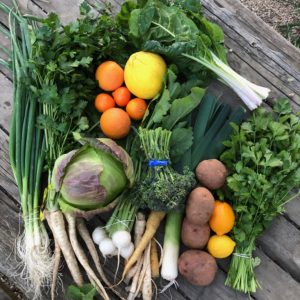 You can get an education of sorts from supporting a local farm too. It’s so easy to find anything from anywhere that a person can almost be excused for having no clue what’s “in season.” It’s always summer somewhere in the world so there’s almost always going to be fresh corn on the cob at some price. But eating locally means living through the seasons with all the ups and downs of the region we live in. Here in the Bay Area we’re blessed with an extraordinary range of local products. Eating seasonally doesn’t have to mean having to give up on things when they’re out of season; we can think of each season as an opportunity to enjoy the best of what our region, our climate, our season has to offer.
You can get an education of sorts from supporting a local farm too. It’s so easy to find anything from anywhere that a person can almost be excused for having no clue what’s “in season.” It’s always summer somewhere in the world so there’s almost always going to be fresh corn on the cob at some price. But eating locally means living through the seasons with all the ups and downs of the region we live in. Here in the Bay Area we’re blessed with an extraordinary range of local products. Eating seasonally doesn’t have to mean having to give up on things when they’re out of season; we can think of each season as an opportunity to enjoy the best of what our region, our climate, our season has to offer.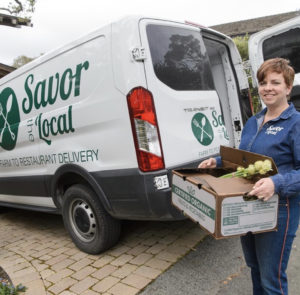 Supporting a local farm can provide a sense of pride in feeling a connection to the people that grow your food and that live in your neighborhood. I’d like to take a moment to thank Colleen Logan for all the support she and Savor The Local have given our farm over the years. Colleen wrote, “I am passionate about what I do. I love supporting chefs who cook with local ingredients that are in season and I enjoy the challenge of bringing interesting and unique items for daily cooking or special occasions,” she says. “I am proud of the fact that the produce is harvested to order and delivered just in time. 95% of what I deliver was harvested that day or the day before. I directly help small farms thrive, by letting them set the prices, the minimum for each item and working with their schedules and means of communication. I also really enjoy the personal relationships I have with each farm and some amazing local chefs.” Her words sure gave me a sense of pride. Thanks, Colleen.
Supporting a local farm can provide a sense of pride in feeling a connection to the people that grow your food and that live in your neighborhood. I’d like to take a moment to thank Colleen Logan for all the support she and Savor The Local have given our farm over the years. Colleen wrote, “I am passionate about what I do. I love supporting chefs who cook with local ingredients that are in season and I enjoy the challenge of bringing interesting and unique items for daily cooking or special occasions,” she says. “I am proud of the fact that the produce is harvested to order and delivered just in time. 95% of what I deliver was harvested that day or the day before. I directly help small farms thrive, by letting them set the prices, the minimum for each item and working with their schedules and means of communication. I also really enjoy the personal relationships I have with each farm and some amazing local chefs.” Her words sure gave me a sense of pride. Thanks, Colleen.- If you care about your local environment and economy it makes sense to find a farmer in your area that has values you want to support. We want to thank all of you reading this because most of you have supported us for a long time through the purchase of our Mystery Boxes and farm products. We hope you will continue to support us and help us get the word out to others that might be interested in good ol’fashioned, locally sourced, farm fresh produce!
The seasons are marching forward. We plant basil this week, and the first summer squashes get sown in the trays. By popular convention our “frost-free” date here in Santa Cruz County is usually thought of as April 15th so we’ll have lots of transplants coming out of the greenhouse around that time. Life is about to get really busy and I’m optimistic about the outlook for the upcoming season.
Thanks, for your support!
Andy and the Crew at Mariquita Farm.
© 2021 Essay by Andy Griffin.
Photo of Gayle at a Piccino Mystery Thursday by Debra Baida.
Photo of Linda Ferrasci’s sheep by Linda Ferrasci.
Photo of pick up site with totes and mystery boxes by Gayle Ross.
Photo of Colleen Logan and the Savor the Local van by Michael Troutman.
All other photos by Andy Griffin.
Did You Say Chayote?
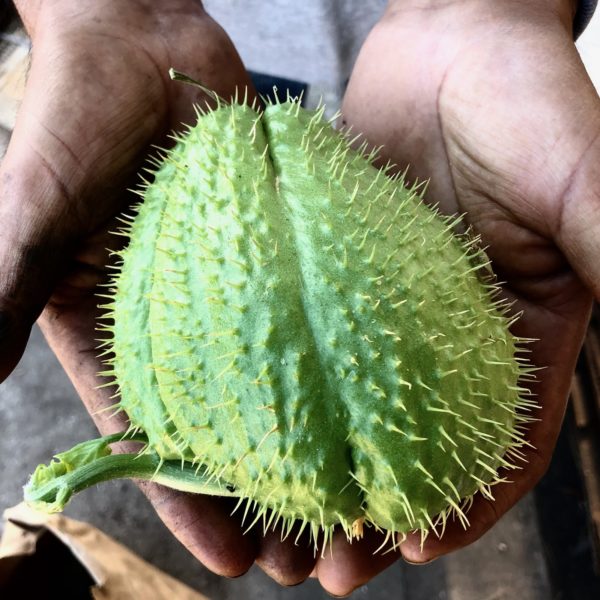
We’re still seeing rain and cold night temperatures, but spring planting is underway. The potatoes are in the ground, and the basil seed arrived yesterday. Along with corn, squash, tomatoes, chilies and beans, I’ll be trying some chayote this year. Maybe my 2nd time will be the charm.
Several years ago Don Gerardo brought me a chayote from his home in Michoacan and it already had a stem emerging. We planted the fruit at the foot of an Ash tree in my yard and it grew rampantly up into the crown. Eventually, there were some flowers, and then a single fruit formed, but then we had a frost and the whole plant died. This time, I’m thinking that if I plant the Chayote earlier in the year than I did last time it will have more time to set more flowers and create a bigger crop.
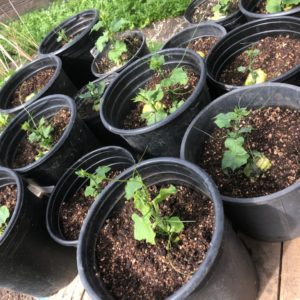 Chayotes are in the squash family, but they behave a little differently than the zucchini. Give it time to grow and the chayote plant will form a large underground potato-like tuber. When a frost kills the foliage, the chayote can always sprout back from the tuber and grow new vines. (I’m also growing the Scarlet runner bean this year, which shares the Chayote’s Central American origin, and it too, develops a tuberous habit. I’m betting the weather is unstable there and it serves the plants well to have a 2nd way of survival if the seed crop can sometimes be destroyed by unpredictable invasion of icy weather.) The habit of the chayote is rampant, clambering over everything in its path, climbing up trees, crawling over walls. It’s the custom in rural Mexico, where the chayote is at home, to let the chayote’s vines scramble into trees. But I don’t want to climb a tree to harvest a squash, so I’ve built some tall frames on the sunny, south side of our home garden for our chayote.
Chayotes are in the squash family, but they behave a little differently than the zucchini. Give it time to grow and the chayote plant will form a large underground potato-like tuber. When a frost kills the foliage, the chayote can always sprout back from the tuber and grow new vines. (I’m also growing the Scarlet runner bean this year, which shares the Chayote’s Central American origin, and it too, develops a tuberous habit. I’m betting the weather is unstable there and it serves the plants well to have a 2nd way of survival if the seed crop can sometimes be destroyed by unpredictable invasion of icy weather.) The habit of the chayote is rampant, clambering over everything in its path, climbing up trees, crawling over walls. It’s the custom in rural Mexico, where the chayote is at home, to let the chayote’s vines scramble into trees. But I don’t want to climb a tree to harvest a squash, so I’ve built some tall frames on the sunny, south side of our home garden for our chayote.
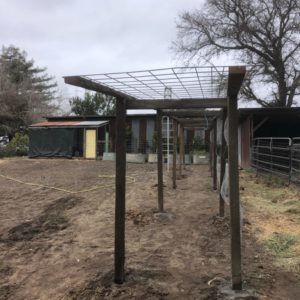 I’ve got several varieties of Chayote, about fifteen potted plants in all, growing in my greenhouse. When the danger of frost is over, I’ll transplant the chayotes under the frame. As the spring advances into summer the vines will cover the frames like a canopy, and the ripe fruit will hang down through the screen at the top so that it can be picked. Fidel, who manages the production in the greenhouse, gave me the fruits. When the season is over we’ll know if planting them on a larger scale is a good idea. I like the idea that the chayote is popular in South East Asian AND Latin American cooking. I’m going to enjoy getting to know the plant. I’m hoping we’ll have a crop to share by late summer.
I’ve got several varieties of Chayote, about fifteen potted plants in all, growing in my greenhouse. When the danger of frost is over, I’ll transplant the chayotes under the frame. As the spring advances into summer the vines will cover the frames like a canopy, and the ripe fruit will hang down through the screen at the top so that it can be picked. Fidel, who manages the production in the greenhouse, gave me the fruits. When the season is over we’ll know if planting them on a larger scale is a good idea. I like the idea that the chayote is popular in South East Asian AND Latin American cooking. I’m going to enjoy getting to know the plant. I’m hoping we’ll have a crop to share by late summer.
Thanks! Andy
© 2021 Essay and photos by Andy Griffin.
The Mystery Behind the Lemon
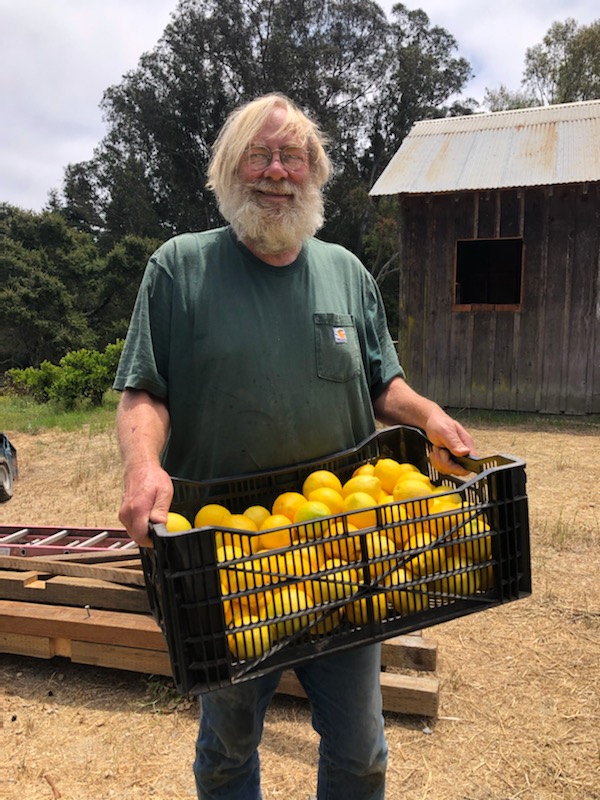
“When life gives you lemons, make….” Yada, yada, yada, you know how the saying goes. As pithy quips go, this sour cliche is not without its wisdom, but I find it’s hint of disdain for this versatile fruit distasteful, as though there’s something wrong with a lemon. The lemon is a gift! Just imagine if you had the misfortune to be born in Europe before the lemon was introduced from Southeast Asia. To a modern botanist, the Latin name for lemon is Citrus medica, but that reflects a consensus in the scientific community to use a highly modified form of the Latin language for taxonomic nomenclature; there wasn’t a word in classical Latin for lemon. Not only did the Romans not have the tomato, the potato, the bean, the squash, the chile pepper, or the corn plant, they didn’t have the lemon. When life finally did gave the Romans the lemon- via the discovery of a direct sea route from the southern Red Sea to India- the produce distributors of the Empire made MONEY. Lemons are great.
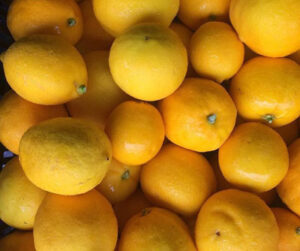 For the last ten years or so I’ve been planting lemons at my house. I started with some Meyer lemons, because they’re very popular and I enjoy their balance of sweet and sour. But the Meyer lemon is not a “true” lemon. Meyer was the fellow who encountered the “Meyer” lemon in the hinterlands of China, but make no mistake, it was the Chinese who developed the fruit by crossing the citron with a Mandarine orange/pummelo hybrid. Indeed, if you let a Meyer lemon hang on the tree for a long time, the fruit begins to pick up an orange cast to the skin which betrays the Mandarin heritage. The extra sweetness that the fully mature Meyer possesses is another hint that the fruit is not a true lemon. When life gives you Meyers, make dessert.
For the last ten years or so I’ve been planting lemons at my house. I started with some Meyer lemons, because they’re very popular and I enjoy their balance of sweet and sour. But the Meyer lemon is not a “true” lemon. Meyer was the fellow who encountered the “Meyer” lemon in the hinterlands of China, but make no mistake, it was the Chinese who developed the fruit by crossing the citron with a Mandarine orange/pummelo hybrid. Indeed, if you let a Meyer lemon hang on the tree for a long time, the fruit begins to pick up an orange cast to the skin which betrays the Mandarin heritage. The extra sweetness that the fully mature Meyer possesses is another hint that the fruit is not a true lemon. When life gives you Meyers, make dessert.
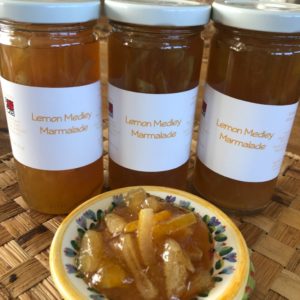 But as popular as the Meyer has become, the true lemon still has its fans. There is a bitterness to a true lemon that adds an attractive element of complexity to many dishes that the Meyer can’t match. When I saw how well the Meyer lemons did on the south facing slope of the field below my house I decided to diversify my little grove with a number of different “true” lemons. I planted Eureka lemons, Lisbon lemons, Femminello lemons, and a Santa Teresa lemon or two. Unfortunately, I didn’t keep the names straight, so I have a small lemon zoo of unnamed varieties. I guess you could say that when life sold me lemons I paid for the young trees but I didn’t pay attention. At least I’m having fun trying to rediscover the names of the plants I’m cultivating and when I gave Happy Girl Kitchen 300 pounds of mixed up lemons they made Lemon Medley Marmalade.
But as popular as the Meyer has become, the true lemon still has its fans. There is a bitterness to a true lemon that adds an attractive element of complexity to many dishes that the Meyer can’t match. When I saw how well the Meyer lemons did on the south facing slope of the field below my house I decided to diversify my little grove with a number of different “true” lemons. I planted Eureka lemons, Lisbon lemons, Femminello lemons, and a Santa Teresa lemon or two. Unfortunately, I didn’t keep the names straight, so I have a small lemon zoo of unnamed varieties. I guess you could say that when life sold me lemons I paid for the young trees but I didn’t pay attention. At least I’m having fun trying to rediscover the names of the plants I’m cultivating and when I gave Happy Girl Kitchen 300 pounds of mixed up lemons they made Lemon Medley Marmalade.
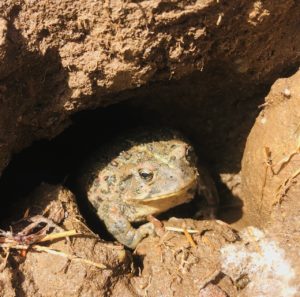 Today I spent the morning watering my citrus since it appears like we’re not going to get enough rain. I was also weeding around the base of the trees and getting ready to fertilize the crop. I use a special OMRI approved organic fertilizer twice a year, and I also toss on a handful of seaweed meal. Seaweed has a rich blend of trace elements and minerals which help the plant create interesting flavors. As I dug around the trees I unfortunately unearthed a drowsy toad. He ( or she or they) did not look all that happy to be disturbed, but lucklily wasn’t harmed. I thanked the creature for eating flies and mosquitoes and let it go back to sleep in the mud. When life gave the toad a lemon tree it made a home.
Today I spent the morning watering my citrus since it appears like we’re not going to get enough rain. I was also weeding around the base of the trees and getting ready to fertilize the crop. I use a special OMRI approved organic fertilizer twice a year, and I also toss on a handful of seaweed meal. Seaweed has a rich blend of trace elements and minerals which help the plant create interesting flavors. As I dug around the trees I unfortunately unearthed a drowsy toad. He ( or she or they) did not look all that happy to be disturbed, but lucklily wasn’t harmed. I thanked the creature for eating flies and mosquitoes and let it go back to sleep in the mud. When life gave the toad a lemon tree it made a home.
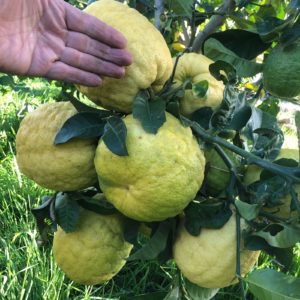
Cuban Shaddock
The different lemon varieties differ in size, shape, flavor, and season of yield. One tree is a standout, the fruits are enormous with an extremely thick rind. I spoke with the nursery where I’d purchased the trees. It turns out that my “lemon” was actually a Cuban Shaddock. For many years the Cuban Shaddock was used as a rootstock because of its vigor and disease resistance, and then a lemon scion was grafted on. A freeze had killed the lemon tree but the rootstock survived and now is fruiting. I’ve kept the Shaddock tree because it’s so entertaining. The Shaddock fruit is good too, but there’s not much of it inside all the pith. I also learned that the use of the Shaddock as a rootstock can sometimes make for lemons which have unusually thick peels, so nowadays the nursery has switched to other types of rootstock. So what do you do if life gives you a lemon with a thick rind? Make lemonade? Most of the lemony flavor in a lemon comes from the essential oils in the skin, nit from the juice. Here’s how I make lemonade:
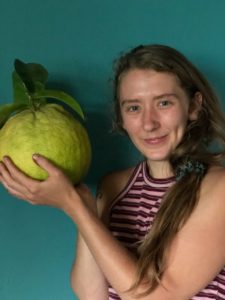
Eliza with a rather large lemon.
Use a vegetable peeler to slice off the colored part of the rind before you squeeze the lemons. I make a simple syrup by bringing two cups of water to a boil and then I add a cup of sugar and a generous handful of lemon peels. I let the lemon peels simmer in the sugar water for ten minutes of so, then I let the mixture cool before removing the skins. After I’ve juiced the lemons I add water and the lemony simple syrup until I find the balance I like. I find that most recipes make a lemonade that is far too sweet for my taste so I won’t tell you how much sugar to use, but I can assure you that the lemony syrup gives a real citrus punch to the drink. Sometimes for fun I’ll use several different kinds of citrus peels to jazz up the lemonade or I will make a batch of limoncello to use in a cocktail. Wintertime is citrus time on the farm, and this week life is giving you lemons. I hope you enjoy them as much as I do.
© 2021 Essay by Andy Griffin.
Photos by Starling Linden and Andy Griffin.
It’s Time to Say Thank You
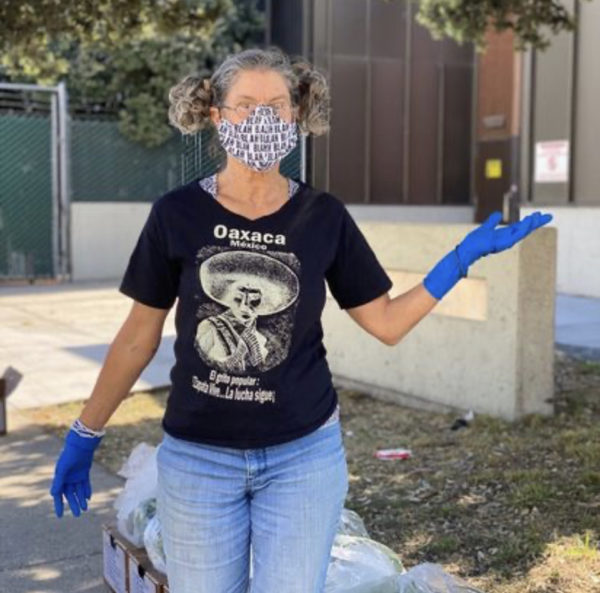
“Do you bathe,” she asked me. “Are you interested in personal hygiene?”
I took my time answering these questions and looked back at the woman who was interviewing me.
“Seriously,” she continued. “The job you’re applying for is primarily a forklift driving/warehouse worker job, but there are some deliveries to make and some inevitable interactions with the public. This business is a co-op with several owners so if we hired you, you’d have several “bosses.” One of the “owner/partners” doesn’t believe in taking a bath or a shower and, in fact, he’s now saying that to wash his body is to destroy the lives of millions of microbes…. So he stinks…. He stinks so bad that some of the stores we serve have called to say that if we don’t find another driver they’re going to stop ordering. So, I ask again, ‘Do you bathe?’ If you don’t want to wash , if showering is ‘against your religion,’ then hey, that’s fine; no judgement…..but no job.”
“I take a bath every day,” I replied.
“Great,” she said. “You can start right now.”
So that’s how Dorothy came to hire me at Organic Matters Produce Company, on Monday, May 25th, 1989. It would have been after midnight not long after that job interview when I first met Gayle, the company’s bookkeeper. Some of you have gotten to know Gayle too, because she’s been taking the lead at our bi-monthly pop-ups at Piccino for a number of years. Sometimes I’ll get a nice note or see a complimentary post on Instagram or Facebook that says something positive about the produce we provide and they’ll thank me. I like the positive strokes, but I know it’s never me that made the nice array of veggies happen- it’s always a team effort. Gayle has played a big role in keeping our farm going over the years. After April she’ll be stepping back from her regular work schedule. I’m not saying “goodbye” to Gayle, but it’s never too early or too late to tell someone how much they mean to you.
Organic Matters was a good job for me. The company bought produce from all the local organic growers and distributed food around the local area and up as far as San Francisco so working there gave me an opportunity to get to know a lot of people I’d be working with for the next 30 plus years. If you’re trying to add up figures or figure out how someone else buggered up a whole pile of invoices it can help not to be distracted by all the shenanigans and drama that can occur in a busy office during the day. Gayle liked to work nights when the office was empty. I’d be there working too, but I’d be tucked away in a refrigerated warehouse, so I wasn’t on hand to bug her much.
In 1990 I farmed with Gayle’s husband, Joe, at Frogland Farm until the big freeze that December of that year, when temperatures dropped down below freezing and stayed that way for the next two weeks, even during the day, so that all the crops turned black and fell over. A competent bookkeeper can add up figures and keep the books straight, but a great bookkeeper doesn’t freak out and lose their professionalism when the numbers aren’t rosy. Organic Matters went out of business, Frogland shut down, but Gayle stayed busy working for other organic farms and for like-minded organizations like the Eco Farm Conference. When Mariquita Farm needed a real bookkeeper Gayle came to mind. And Gayle took the job, but only on the condition that we never ask her to wear high heels to work! We got a big laugh about that.
As a bookkeeper Gayle was always the soul of discretion, and she saved me from myself any number of times. Unlike many competent bookkeepers though, Gayle doesn’t have any problem with leaping up from the keyboard to go and load a truck, or drive it off on deliveries. She’s a very capable woman. Gayle has stepped in to help Mariquita Farm and my family many times over the years. She’s one of the people I know who are calm and principled and empathetic in a way that makes you want to be a better person. All these years later I am happy to call Gayle a good friend.
Thinking about Gayle is bringing me back to Organic Matters. While I worked there I ended up filling in wherever I was needed, which put me behind the sales desk at times. I remember one day looking up from my phone when Dorothy was clearing the air with Russell, a delivery driver, over some egregious failure on his part. “Honestly, Russell,” she said. “Sometimes I think you really don’t like driving.”
“That’s where you’re wrong, Miss Dorothy,” Russell replied. “I LOVE to drive- I just effing hate to stop.”
We got a kick out of that answer. What is food distribution if it’s not about stopping to unload food?
This week we’ll be stopping for you. I’m happy with this box. It’s winter, which is always a hard time on the farm, but the box is looking good. There are a few things that I ought to mention, though; If you’re not going to use your Hamburg parsley right away then you should cut the leaves off and store the roots in a sealed bag or container. The Yellowstone carrots are bagged up with any of the stray Parsley roots that fell off in the harvest, so you can put them together. Hamburg parsley is a very fun crop; you can cut the roots up into chunks and cook them with potatoes if you want to make an herbal infused mashed potato dish. Parsley roots are good roasted too, along with carrots, beets, radishes, or turnips. Speaking of turnips, the Tokyo turnips in your box will roast up great, and the greens are tender enough for salad.
The citrus in your box is a mix of a number of different kinds of citrus from our friend, Zea, at Fruitilicious Farm. Zea is my “citrus coach.” Her orchard is just up the hill from our farm, so I figure if crops grow well for her there, they should do well for me. Right now the mix that Zea can harvest includes some, if not all of the following:
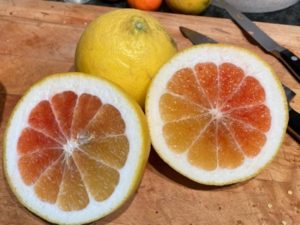 Valentine Pummelo –
Valentine Pummelo –
A very pretty half-pummelo hybrid from UC Riverside involving the very interesting acidless ‘Siamese Sweet’ pummelo crossed with a Dancy-Ruby Blood Orange hybrid. Delicious flesh is juicy and sweet, with a thick rind that makes it easy to peel.
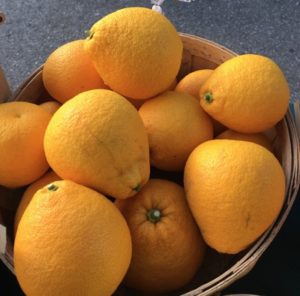
Bloomsweet “Grapefruit” (Pummelo) –
(Citrus obovoidea) Also known as Kinkoji in Japan. Large yellow grapefruit-like fruit, but without the bitterness typical of grapefruit and with a thick rind like a pummelo. Chewy but pleasant flesh makes interesting juice.
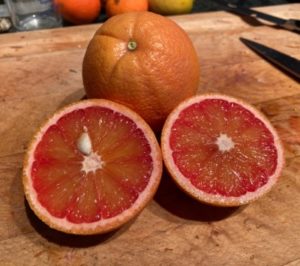
Vanilla Blood Orange –
Vaniglia Sanguigno in Italian. This is an acidless orange with lovely pink flesh that is best blended in juice with tart citrus or other oranges. Sweet and juicy, but a bit insipid by itself.
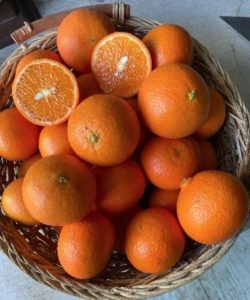
Fremont Mandarin –
Very sweet and juicy mandarin with few seeds. Small to medium size fruit is dazzling orange.

Meyer lemon —
Not a true lemon because it has some mandarin in the gene pool, but with a nice tart punch that’s got some sweetness too. Juice one of these with the Vaniglia for a glass of very interesting orange juice.
We strive to bring the familiar favorites to your kitchen but we also like to bring you the unique crops that each season has to offer.
Did someone say it’s March!?
Enjoy.
Andy and the Crew at Mariquita Farm
© 2021 Essay by Andy Griffin.
Photo of Gayle by Debra Baida.
Photos of citrus (except as noted) by Zea Sonnabend.
Photo of Meyer Lemons by Andy Griffin.
Cabbage Family Reunion
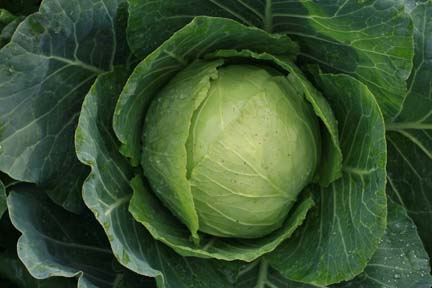
The time has come,’ the Walrus said,
To talk of many things:
Of shoes — and ships — and sealing-wax —
Of cabbages — and….
~ Lewis Carroll, The Walrus and The Carpenter
The warm temperatures notwithstanding, it’s still winter so I’m going to step out on some thin ice and tell an ethnic joke at the expense of the Polish people. But before I do I’d like to share a small personal triumph. If you’re going to have kids, it’s probably a bad idea to count on having your efforts as a parent validated too soon, but I’m feeling good today. I’m a vegetable farmer and I enjoy cooking so of course I wanted my children to eat veggies. When he was young my son, Graydon, went through a phase where he’d only gladly eat “white food,” and by that I mean white rice, white cheese, and white bread. He’s 25 now and that time is thankfully long past. He grew up to discover a passionate interest in all things Asian, and that included getting a degree in Mandarin, and then he lived in Taiwan for a while. While in Taiwan he began teaching himself basic Chinese cooking techniques, and now that he’s back here he’s only amplified his interest. Not infrequently, he’ll text me pictures of what he’s cooking and I enjoy seeing how far he’s taken his interest. The Chinese have a way with cabbage, for sure, and it makes me feel good to see how Graydon’s childish abhorrence of vegetables is a distant memory.
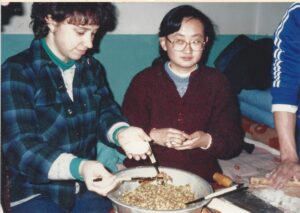
Julia preparing dumplings in Beijing, China, 1987.
Graydon’s mother, Julia, lived in mainland China for a while when she was just out of college too, and she used to tell me that you could tell winter was coming when the trucks would roll into the cities loaded with cabbages. The people would buy loads and loads of cabbages and stack them up outside their homes. The weather was so cold that the whole world was like a refrigerator, so the cabbage would keep pretty well outside. Every day the people could bring a head or two inside, peel off a yellow leaf or two, and commence to make a meal. As a mother and a passionate cook and a confirmed Sinophile, Julia would love to see these texted photos of Chinese dishes that I receive rolling in from our son, but she passed away 6 years ago. In my experience grief is like a well-mannered dog that never leaves your side and remains quiet most of the time, usually choosing to put it’s nose in your hand and beg for attention up during moments of joy. I feel happy our son is cooking vegetables and enjoying Chinese food, and I feel sad that Julia is not here to share the moment. But that’s life, and grief is a part of life like a shadow that makes colors stand out more, or like a salt that deepens other flavors. But enough about other things; let’s talk cabbage.
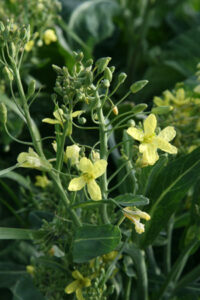
Cabbage flower
Of course the cabbage that is most common in China is what we’d call Napa Cabbage here. Napa is a Brassica- Brassica rapa, related to the round Brassica oleracea cabbage that is most common in the west, but not closely. All Brassicas have tiny round seeds, paired valentine-shaped cotyledons when they germinate, and show off characteristic 4 petaled flowers when they reach sexual maturity, but beyond that they vary widely in form. A lot of the Brassicas grow well in cool weather, and the family really comes into its own in the kitchen during the winter. We’ve got a number of different Brassicas planted for you. This week it’s a regular cabbage family reunion in your harvest box; cabbage, broccoli and kale, for sure, and maybe turnips by week’s end if the little roots swell up fast enough. Like most garden plants, Brassicas grow easily enough if you give them what they want. These cabbages of ours grew easily enough, but we did make a mistake that I’d like to point out.
Cabbages are so important economically all over the world that plant scientists have worked to develop varieties for every season and growing region. These cabbages began to form heads just like they’re supposed too, but they didn’t get heavy. I suspect we erred and planted a variety in the fall that should have been planted in spring. All cabbages are fairly cold tolerant, but they behave differently under different light conditions. Some varieties perform best when the days are getting longer, as in the spring. Other varieties develop better when the days are getting shorter, as in the fall. Seeing that these cabbages were getting ready to bolt without getting heavy made me think we’d better pick them now. They taste good, but they’re light for their size. In the future we should probably plant this type in the spring so that it can grow super fast under the conditions of increasing day length; that way we’ll get the weight we want before the plants want to go to flower. These cabbages must be watching their mustard cousins blow up into a blaze of yellow flowers and they want to follow them. Which brings me back to my son, Graydon.
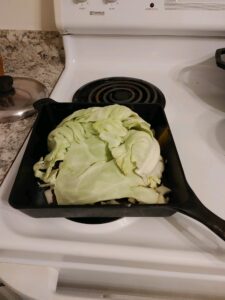
Salmon wrapped in Polish foil
Many, but not all Chinese Brassicas are members of the mustard side of the family; think turnips, gai-lan, the various choy types, mizuna, or the many mustards and radishes the Chinese favor. Graydon often cooks Chinese food, so I was surprised when he sent me a picture that I didn’t recognize as anything Chinese. I asked him what it was. “Salmon wrapped in ‘Polish foil,’” he responded. I still didn’t understand the joke, so he amplified. He’d gotten ready to make a baked salmon dish with a miso glaze and the recipe called for aluminum foil, but he didn’t have any, so he improvised and used green cabbage leaves. He’d been working with someone of Polish ancestry who’d turned him onto stuffed cabbage recipes and joked that cabbage leaves are “Polish foil.” And he told me something else that I never knew but that is apparently common knowledge among informed cooks all over the world from Warsaw to Beijing; cabbage is high in glutamates, those natural amino acids that lend “umami” to food- think monosodium glutamate, but natural. My days of schooling the kid on food are long over, and it’s my turn to learn.
Meanwhile, back on the ranch we are getting potatoes ready to plant, we’re transplanting more kohlrabi and lettuces, sowing trays of peppers, and watching the tomato seedlings get bigger.
© 2021 Essay and Photos by Andy Griffin.
Kohlrabi Rising
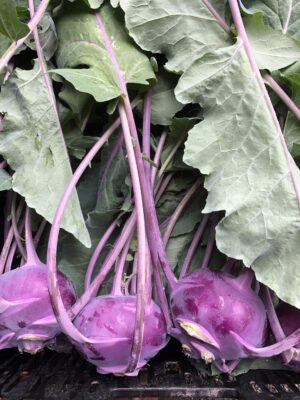
The humble kohlrabi and anoint it as the next “it” vegetable. Why not? Kale got the “celebuveggie” treatment and kale salads sprouted up on menus from Malibu to Muskogee! I’m not the world’s biggest kale salad fan, despite being a kale grower, because I think the texture is a bit much, and when I make a “kale salad” I prefer to use spigariello, but kohlrabi greens would work too, and they’re both a lot more tender on the tongue than kale.
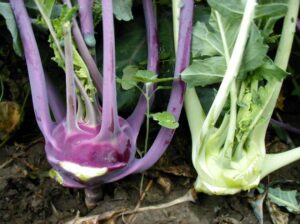 Kale, spigariello, and kohlrabi are all members of the Brassica oleracea group- along with collards, cabbage, broccoli, Brussels sprouts, and cauliflower. Brassica oleracea is a star among vegetables. When you see them growing together you can see how they’re all family, but they look diverse from a distance. With kale and spigariello it’s the leaves that are valued, but cauliflower’s inner, more tender leaves can be cooked with good results. With cabbage and Brussels sprouts we’re still eating the leaves, but they grow curling inward to form heads and don’t open outwards into a rosette like the kales, collards and spigariello. With Broccoli and cauliflower we’re eating the emergent, immature flower buds. But with kohlrabi we focus on the bulbous, swollen stem, which looks round, like a turnip that is on top of the ground, but the leaves are good food, and if you let the plant go to flower the floral buds could be consumed like tiny broccolis. All the members of the Brassica oleracea are so closely related that they can cross-pollinate like dogs into myriad mongrel forms.
Kale, spigariello, and kohlrabi are all members of the Brassica oleracea group- along with collards, cabbage, broccoli, Brussels sprouts, and cauliflower. Brassica oleracea is a star among vegetables. When you see them growing together you can see how they’re all family, but they look diverse from a distance. With kale and spigariello it’s the leaves that are valued, but cauliflower’s inner, more tender leaves can be cooked with good results. With cabbage and Brussels sprouts we’re still eating the leaves, but they grow curling inward to form heads and don’t open outwards into a rosette like the kales, collards and spigariello. With Broccoli and cauliflower we’re eating the emergent, immature flower buds. But with kohlrabi we focus on the bulbous, swollen stem, which looks round, like a turnip that is on top of the ground, but the leaves are good food, and if you let the plant go to flower the floral buds could be consumed like tiny broccolis. All the members of the Brassica oleracea are so closely related that they can cross-pollinate like dogs into myriad mongrel forms.
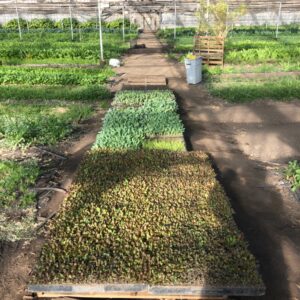
Lettuce and kohlrabi trays in the greenhouse, ready to transplant out.
I love kohlrabi because the fat, round stem is sweet and crunchy like jicama. Kohlrabi can be cooked- steamed or cubed and stir fried, or grated and folded into latkes or dressed as coleslaw, but I usually just eat it raw, sliced and dressed with a little Meyer lemon juice. I’ve grown both purple kohlrabi and green kohlrabi and come to the conclusion that the purple form is consistently sweeter than the green variety, so that’s what you’re getting today. Later in the season we’ll harvest a super large sized green kohlrabi variety that is popular in Germany and I’ll be excited to try it because I’ve never grown it before. The seed is expensive so I’ve got it sprouting under cover in trays in the greenhouse for transplant later instead of being sown directly in the ground where it would be in danger of being pecked up by birds. The large form of kohlrabi will be ready for transplant in a month or so, and harvest will commence in May when warm weather will make crisp, crunchy salads very appealing.
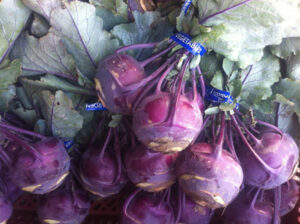 Kohlrabi was developed in Northern Europe and is most commonly associated with German, Dutch and Scandinavian cuisine, but the crop has found an unlikely home in the cooking of Northern India and Nepal. Colonial powers introduced the plant to India and farmers there found that the crop did well for them because the plump, crisp ball of a swollen stem that makes up the best portion of the plant rests on top of the ground, and not in the ground, like a turnip, so it is less susceptible to damage from pests like nematodes that live in the soil. If you strip the leaves off the ball so that the plant doesn’t continue to transpire after harvest- and thus wilt- and if you keep the harvest in a cool place they will “keep” for a long time. You’re not going to want to keep the kohlrabi that you get in you box for long though. They’re going to taste so good you’ll gobble them up and wonder why I didn’t send you more. Don’t worry; I’m working on it.
Kohlrabi was developed in Northern Europe and is most commonly associated with German, Dutch and Scandinavian cuisine, but the crop has found an unlikely home in the cooking of Northern India and Nepal. Colonial powers introduced the plant to India and farmers there found that the crop did well for them because the plump, crisp ball of a swollen stem that makes up the best portion of the plant rests on top of the ground, and not in the ground, like a turnip, so it is less susceptible to damage from pests like nematodes that live in the soil. If you strip the leaves off the ball so that the plant doesn’t continue to transpire after harvest- and thus wilt- and if you keep the harvest in a cool place they will “keep” for a long time. You’re not going to want to keep the kohlrabi that you get in you box for long though. They’re going to taste so good you’ll gobble them up and wonder why I didn’t send you more. Don’t worry; I’m working on it.
© 2021 Essay and Photos by Andy Griffin.
Joyful Roaming Through the Countryside

I heard a mighty crash down in the forest below the packing shed but I haven’t gone into the canyon yet to see which tree has fallen. Closer to the outbuildings a mid-sized mature, eucalyptus toppled over, luckily landing away from our barn, not onto it. And along the edge of our yard the old Catalpa tree that had been planted by my Great Grandfather, split into three giant pieces, and now the slope is buried in a tangle of smashed limbs. We’ve had weather; I guess you have too! But the greenhouses are still standing with their roofs all intact, so that’s good. The crops we’ve planted under cover have enjoyed the protection from the storms, and the artichokes and lemons we have out in the fields haven’t been damaged by frost, so far.
We usually elect to take a break at the end of January and into February because the winter conditions can make it hard to harvest enough to keep our veggie delivery program going. The pandemic we’re all suffering through at present turned any wish Starr and I might have had to take a vacation in a warm desert into a palmy mirage, so we elected to enjoy a “staycation” here along the Monterey Bay. The plan was to shut the deliveries down while the crops grew big enough to pick and use the down time to catch up on all the projects that had gone undone. We could spend a day weeding, planting, pruning, cleaning up or organizing, and then venture the following day for a visit to someplace in the Bay Area that we’d never taken the time to know before. Factor in taking a few days to watch the rain coming down, and pretty quick we’re over halfway through the holiday.

Andy above the labyrinth in Oakland’s Sibley Volcanic Preserve
A hike up Mt Madonna was our first tiny trip. We had the idea to go to the tops of all the tallest hills around the Bay Area and look around to get a new fresh perspective on our local world. From Mt Madonna looking south you can see Jack’s Peak in Monterey, and looking east you see the Mt. Diablo Range. Our second trip was to the East Bay, hiking up Round Top behind Oakland to see Mt Diablo to the east and Mt Tamalpais to the northwest. The communities we are looking down on from the high points are the towns that sustain our farm. We thought we’d use our time to get to know them a little better. One of our projects for 2021 is to plant a lavender labyrinth into the field to the south of our home, so we made sure to visit the beautiful labyrinth in Oakland’s Sibley Volcanic Preserve. Volcanoes in Oakland?!
From atop Grizzly Peak Boulevard looking west the San Francisco peninsula stretches out to the Golden Gate, so after several projects got wrapped up, and we’d cleaned up the mess from the windstorm and we headed to Twin peaks and Land’s End. The tiled stairways in the Inner Sunset are gorgeous. It’s so inspiring to see these beautiful gardens and works of art tucked discreetly into quiet, residential neighborhoods. I admire the work that it took to get the stairways planned and accomplished.
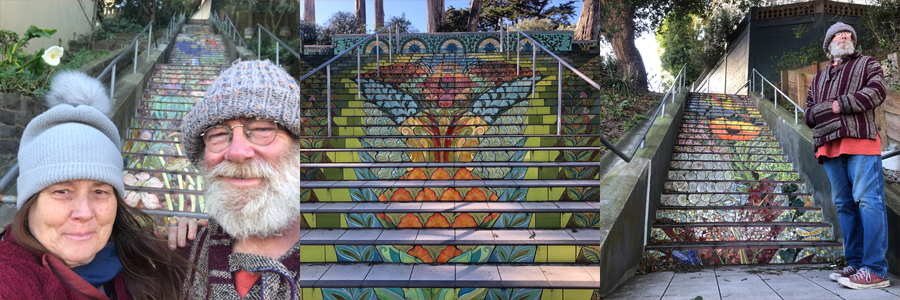
Andy and Starr visit the tiled stairways of the Inner Sunset in San Francisco.
And San Francisco’s labyrinth at Lands End at the Golden Gate was as cool as Oakland’s labyrinth, and yes it really is at the end of the land overlooking a cliff that goes directly into the Pacific Ocean. Life is a maze, with dead ends everywhere, but a labyrinth is more of a spiritual tool offering a calm center at the end of a meandering path. We’ll come out of this pandemic one of these days, and we’re looking forward to a time when we can have visitors enjoy the lavender labyrinth we’re planning. It’s too wet at present to dig the beds, but we’ve got trays of lavender planted in the greenhouse to transplant out when the plants get big enough and lots of great lavender to share once the plants mature.
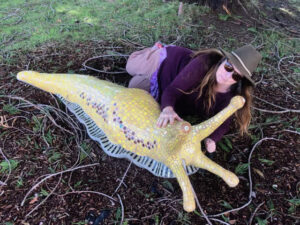
Starling meets a new friend at the UCSC Arboretum.
I’ve got another 65 citrus trees to plant out once this storm passes that’s coming through now. And the tomato seed has been planted for the 2021 summer crop. I managed to get the ground worked up for the spring’s earliest bean planting just hours before the last rainstorm hit, so that feels good. Our next high points to visit will be Mt Diablo, and then Mt Tam. We’ve been hitting the nurseries in the different neighborhoods that we pass through too, and visiting the public gardens. Sometimes farming can feel heavy-like some grim, brown, Dutch painting of a peasant toiling in the mud- so it’s invigorating to see what fun gardeners can have with plants. So far we’ve checked out the arboretum at Villa Montalvo, the Elizabeth
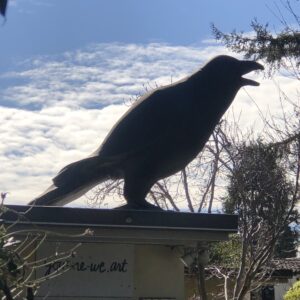
One of the large crow sculptures that were part of a You-We-Me sculpture series by Silvi Herrick.
Gamble garden in Palo Alto and the UCSC Arboretum is Santa Cruz. The Ruth Bancroft garden in Walnut Creek is next on the list, once we get a few more projects tucked away. We were also delighted to see what was left of Greg Browns murals in Palo Alto while taking a street tour though downtown. And then to top it off as we were driving out of Palo Alto along University Avenue, we were excited to see three large crow sculptures, which we later discovered, were part of a You-We-Me sculpture series residing in the driveway of the artist, Silvi Herrick.
We’ll be ready to open back up for deliveries in two weeks. Every season is an adventure of sorts and 2020 was a roller coaster ride, for sure. We’re hoping that 2021 will be calmer. So far, so good! The tables are covered in seedlings sprouting in the greenhouse for transplant out later. Almost all the beds inside the greenhouse have been planted out, and we’ll be finished with that task by week’s end. The artichokes are getting big and fluffy in the fields and drinking up the rain, and the pea plants are starting to reach out with their vines. We look forward to the new season and we’re hoping for your support. If you have friends that might appreciate the food we grow please let them know about our program. We’re looking for more neighborhoods to serve so if you can suggest a likely pick-up spot I’m all ears.
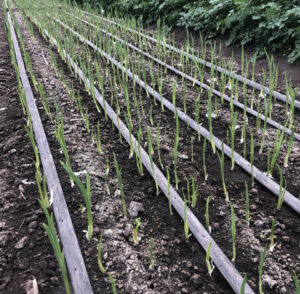
Garlic growing in the greenhouse, February 2021
See you soon!
Andy
© 2021 Essay by Andy Griffin.
Photos by Andy Griffin and Starling Linden
We Will Miss Him
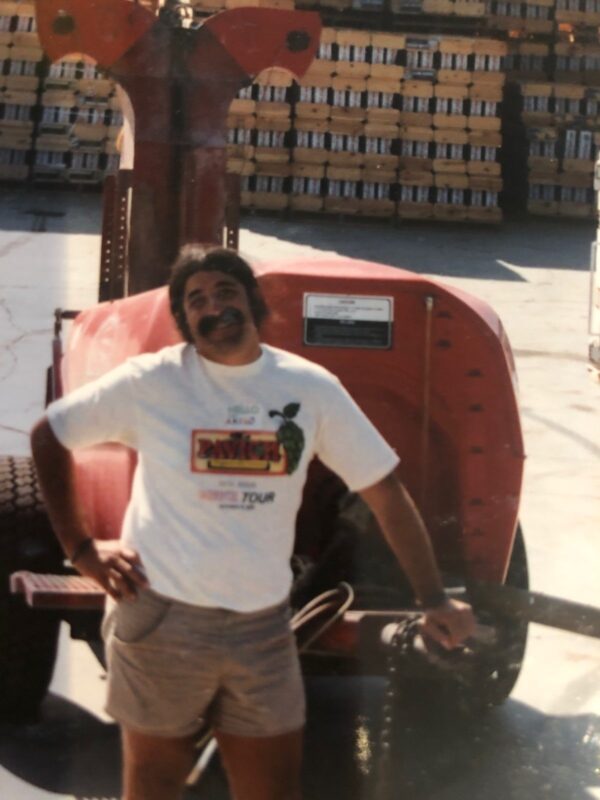
Amigo Bob Cantisano was a true politician and I mean that in the best sense of the word. He passed away the day after Christmas 2020. Amigo changed my life, and if you care about clean food, healthy soil, and a sustainable future for us on this earth, he helped to change yours too. I’m convinced that it would have taken a lot longer for conventional agriculture to change its tune about organic farming practices if it had not been for Amigo’s persistence, determination and leadership.
Was it really 33 years ago? I can still remember the day I met Amigo Bob and Kalita Todd for a job interview at their home in a community in Grass Valley. It turned out to be one of the best days of my life. He ran Peaceful Valley Farm Supply, located in a shack in the middle of the woods up on the San Juan Ridge outside of Nevada City. I remember thinking it was a cool place with lots of great tools and supplies for gardeners and farmers and, if you were one of the lucky ones to get Amigo on the phone, loads of useful advice. I got a job there, my background was in Plant and Soil Science, but this gave me focus and direction pointing me into the world of sustainable agriculture.
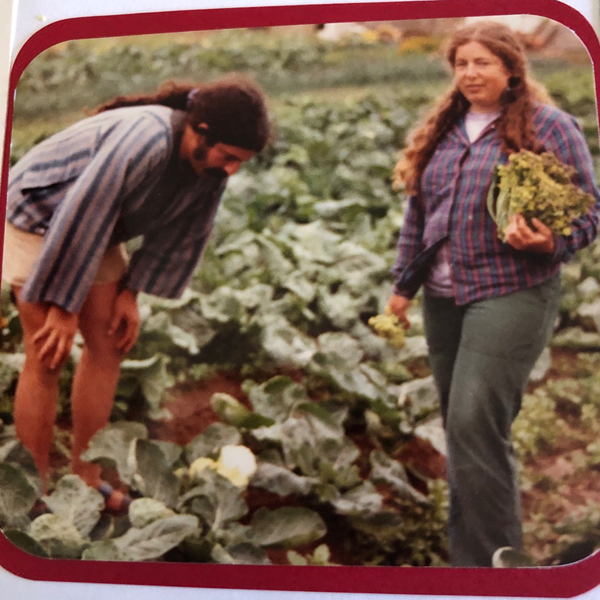
Amigo Bob and Zea Sonnabend (now owner of Fruitilicious Farm) inspecting lettuce, Central Coast, 1990
At the time “Organic” felt like a movement. To be in it was to be surrounded by like-minded people that became lifelong friends. We worked hard to create ways for farmers to grow food without heavy chemical use. Amigo was one of the masterminds and many of us were on his team. Eventually I found myself involved in all sorts of sustainable agriculture activities and for the next 11 years I lived a rich life, much of it under the guidance of Amigo Bob.
Amigo was a lot more than a shopkeeper and farmer. He was a leader in the organic movement and I was a dedicated understudy. I worked with him to present and lead the day long “Sustainable Agriculture Conference Series” held in the places and focused on the crops that used the most pesticides across the state of California. This was one of the projects shepherded by the organization that Amigo founded, known at the time as The Committee for Sustainable Agriculture that eventually became the Ecological Farming Association.
The Committee for Sustainable Agriculture worked tirelessly to persuade conventional agriculture leaders and university agriculture departments that sustainable agriculture was in their best interest. I remember sitting in a meeting in a living room with Amigo and others on the Committee discussing the UC Extension Advisors that were our backroom supporters. These were the first Farm Advisors that were willing to dip their toes into the world of sustainable agriculture. It was a quiet bunch, and they tiptoed out onto the public stage with the help of Amigo’s encouragement.
At the time, doing these conferences was like walking uphill backwards, there was hardly a UC Co-op Extension agent that would say the words “Sustainable” or “Organic” let alone speak on the subject. As the lead organizer of these conferences, I was the one cold-calling UC Extension offices and researchers to invite them to speak. The most memorable day was calling Kern County Extension and having one of the guys say, “what is a woman doing calling to ask about agriculture”, and then responding “no way” would he speak on sustainable or organic farming practices. And then, there were the quiet ones that gladly joined the conversation. We had to carefully craft the topics around their expertise such as cover cropping in vegetables or mite problems on Strawberries or mildew on Grapes. But the point is, we got them in the room and the conversations grew from there.
These same extension agents later went on to start new research projects that would help pave the way for bringing evidence-based science to normalize the practices of cover cropping, or planting beneficial hedgerows, and that by adopting these practices farmers would end up using less pesticides.
When we got frustrated with the resistance from conventional agriculture, Amigo would be our biggest cheerleader, reminding us that there was more work to complete. He carried the torch into the future initiating and completing very important work. He had as many projects up his sleeve as a magician has tricks. One year at the Eco-Farm Conference, along with the wine tasting, Amigo surprised us by bringing 10 different varieties of Olive Oil to taste from olives that he had grown. He was extremely interested in rare fruits and he loved encouraging growers to plant beneficial insectaries. His work became global and eventually farmers from Europe to Central America were calling on him for advice and to help solve their problems.
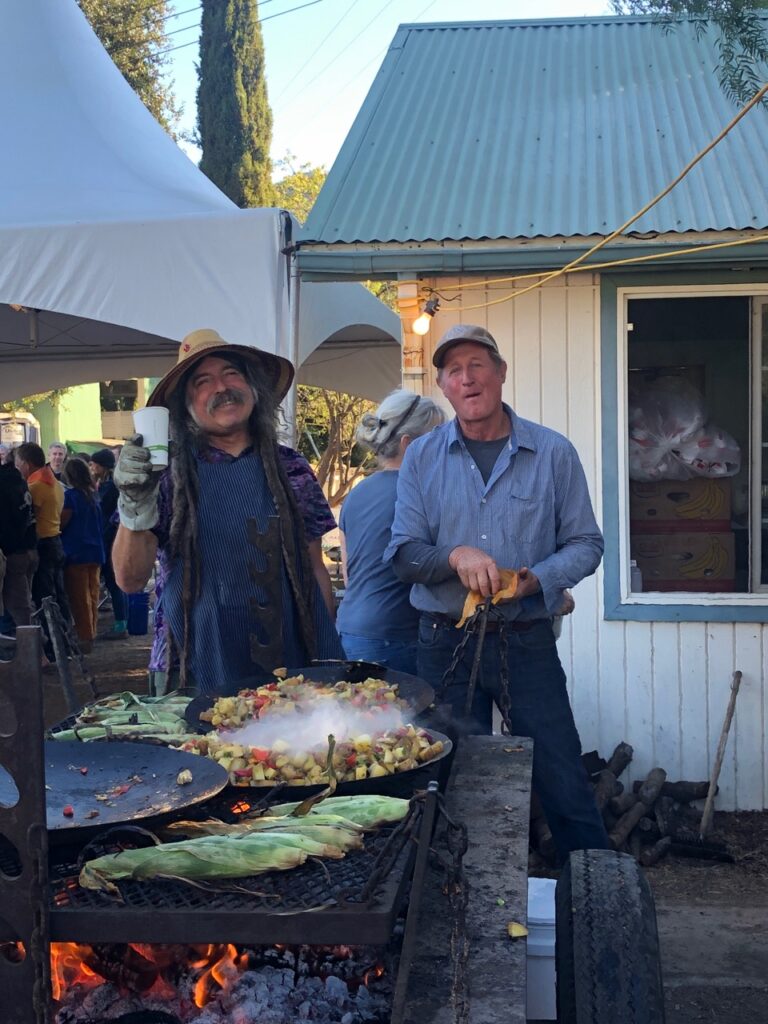
Amigo Bob and Paul Muller, Full Belly Farm, at the Hoes Down Festival 2019
It’s been many years now and lots of us have watched the organic story unfold. We truly were the frontline workers of that movement bolstered by Amigo’s vision, confidence, and dedication. There were lots of us that helped make the changes in agriculture that led to the organic farming laws and institutions we have today. Amigo would credit the farmers that were willing to try something new, the farm advisors that eventually came out in the open, and the willingness of those within the university establishment for having taken these risks to step out of their comfort zone. Amigo was a master of laughing things off and just kept going. He also knew how to have fun. I enjoy remembering how the talent show at the Eco-Farm conference was one of his favorite events to MC, and he loved the farm tours filling us with stories as we rode the bus with him from one farm to the other learning everything we could from farmers working hard to grow food organically.
And now we have what he has left for us – a goldmine of gifts and a boatload of work still yet to do. Thank you, Amigo, for being a pioneer for the Earth, and for all your encouragement and for your work ethic and love. I am grateful for our friendship and your big smile and you are forever in my heart and in the hearts of many.
Starr Linden
© 2021 Essay and Photos by Starling Linden.
Starling Linden has been a part of the organic and sustainable agriculture community since 1987. She worked for the certifying organization CCOF, California Certified Organic Farmers, and the Committee for Sustainable Agriculture for over ten years. She has worked in nurseries and on farms, is an artist and a little more recently, Andy’s partner and working with him on Mariquita Farm.
Top photo: Amigo Bob conducting a farm tour, Central Valley, 1989.
Gifts
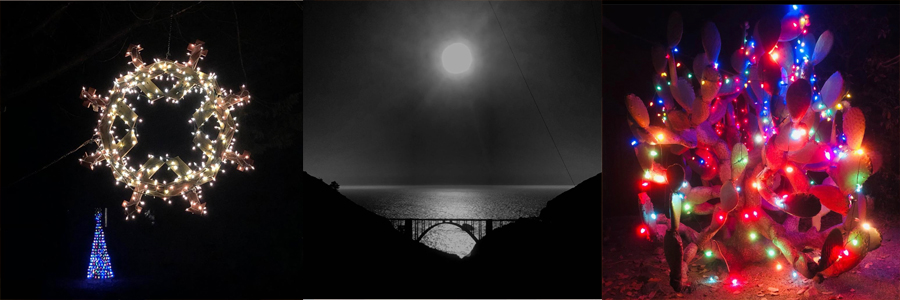
Not all gifts arrive wearing a bow. One of the best gifts my father ever got me was a big pile of dirt. I was five years old and a pickup sized load of topsoil was deposited in our backyard. My father explained that it was all mine and that I could run my trucks and tractors there without pesky regulations getting in the way. What he meant, of course, was that I could no longer run my bulldozers through his petunias. I loved the dirty gift then, and I love the fact that every time I get really dirty I still remember my dad and that moment in 1964.
As “down to earth” as that gift was, another of the best gifts I’ve ever received was also from my father, but of a more cerebral nature. Both my mom and my dad were educated in little red, one-roomed rural schoolhouses and it amazes me to think how much things have changed, they were both taught Latin. I say “taught,” not “learned” because I’m not sure that the lessons were learned by both parents. My mom told me that one of the examples of recess time doggerel that she could remember was the saying, “Latin is a dead language. It died across the sea. It killed the Greeks and Romans, and now it’s killing me.”
But my father remembered his Latin. And because he became a botanist, and because the International language of botanic taxonomy is Scientific Latin, my father had frequent occasions to understand and use Latin as a living language. Dad taught me how language could be understood as more than a convention of arbitrary marks and sounds with stupid arbitrary rules of grammar. He explained what scientific words meant and how you could decode names and turn words into games if you took the time to understand the “roots” of the word. The scientific name for the mint family, for example, is Labiatea, from the Latin “labia” meaning “lips.” The name was given to this plant family because their flowers typically have petals that are fused to form a tube with an upper and lower lip, or labia, at the opening
Getting turned on to the fun of treating language as a code makes everything more interesting. We live in between the communities of Corralitos and Salsipuedes, for example. Spanish is simply an evolved form of Latin that’s been mixed with Arabic and various indigenous pre-Columbian languages so reading our local road signs and looking to the roots of place names makes for a fun exercise in learning history. “Corralitos ” means “little corrals,” and points back to the redwood fairy rings that once served the Spanish conquistadors as little corrals for their donkeys and horses. “Salsipuedes” means, “get out if you can” in the colloquial Spanish of the Mexican cowboys who chased their longhorns through the woods here before the Goldrush, and refers to the steepness of the canyon and the impenetrable brush of the neighborhood.
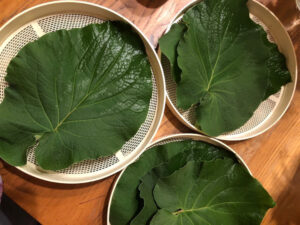 Having fun with language helped me to learn Spanish, which in turn has made my time working with Mexican farmworkers so much more interesting and valuable than it otherwise would have been. I’m thinking now of Fidel, who is the foreman in our greenhouse, and who shares my interest in plants. Starting several years ago he began lobbying me to grow “Hoja Santa.” “Everybody uses the leaf,” he told me, “fresh when they can get it that way, dried when they can’t.” By “everybody” he means “everybody he grew up with in Oaxaca.”
Having fun with language helped me to learn Spanish, which in turn has made my time working with Mexican farmworkers so much more interesting and valuable than it otherwise would have been. I’m thinking now of Fidel, who is the foreman in our greenhouse, and who shares my interest in plants. Starting several years ago he began lobbying me to grow “Hoja Santa.” “Everybody uses the leaf,” he told me, “fresh when they can get it that way, dried when they can’t.” By “everybody” he means “everybody he grew up with in Oaxaca.”
“Hoja Santa” means “Holy Leaf.” But Hoja Santa isn’t a botanic term- it’s a colloquialism, and I often hear the crew call the plant “Yerba Buena,” which means “Good Herb.” So before we planted any of Fidel’s Hoja Santa I hit the books to read up on the plant. Most plants that are called “holy” or “good” are very scented with healing properties, and an astonishing number of them are mint family relatives- the Labiatea with the flowers with lips all pooched out to smooch. Basil is a mint family member. So are the sages, rosemary, mints, shisos, thymes, catnips, oreganos, marjorams, nepitella, horehound, chia- the list goes on and on. I guess my father also gifted me with his love for plants.
But Fidel’s Hoja Santa turned out to be Piper auritum; a pepper plant, related to the Black pepper that we use on our eggs and in our soups and stews. Hoja Santa has a strong, sweet aroma of anis. The plant is no relation to true anis, which is in the Umbelliferea, the “umbel” referring to the umbrella-like shape common to the flower heads of the carrot family. Hoja Santa is also used, as an herb in egg dishes and in soups and stews but it is sweet, not spicy like it’s peppercorn cousin. We’re pruning the plants back now because they’re crowding the aisle in the greenhouse, but also because Fidel tells me “everybody needs Hoja Santa now to make pozole.” Well, maybe “everybody” isn’t making pozole, but Hoja Santa is a good herb for many other soups and stews. It’s also used to wrap cheeses in because it imparts some of its scent to the cheese and is delightful in egg dishes.
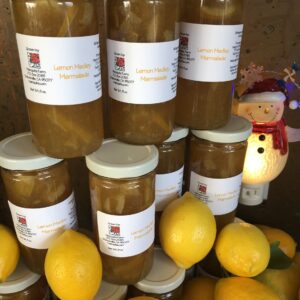 When I think about the scientific names of plants my father comes alive for me again, and that’s a gift. I wonder what gift I gave him that meant a lot? One gift I gave my father still means a lot to me. He wasn’t an easy person to give things to because he didn’t really want much and didn’t seem to need much (except for peace and quiet). He had simple tastes and was always satisfied with a peanut butter and jelly sandwich. Expensive bottles of wine would have been wasted on him – he drank water. But I observed that he enjoyed marmalade, so every Christmas I’d go to the Mediterranean Market in Carmel and get him little ceramic pots of orange, lemon, and lime marmalade imported from Scotland. Now we’re picking our own lemons and Happy Girl Kitchen in Pacific Grove, CA. is making marmalade for us that is available for purchase on its own or in our citrus gift bags. Our lime and orange trees are growing right behind the lemons and will be ready to harvest in a couple of years. He’d like the marmalade and I like to think that he’d like to see what we’ve done to the family ranch. My father gifted me a quarter interest in this property and I was able to gradually buy the rest of the family out. With this land, just like his love for language, for plants, and for soil, my father gave a big gift that keep on giving.
When I think about the scientific names of plants my father comes alive for me again, and that’s a gift. I wonder what gift I gave him that meant a lot? One gift I gave my father still means a lot to me. He wasn’t an easy person to give things to because he didn’t really want much and didn’t seem to need much (except for peace and quiet). He had simple tastes and was always satisfied with a peanut butter and jelly sandwich. Expensive bottles of wine would have been wasted on him – he drank water. But I observed that he enjoyed marmalade, so every Christmas I’d go to the Mediterranean Market in Carmel and get him little ceramic pots of orange, lemon, and lime marmalade imported from Scotland. Now we’re picking our own lemons and Happy Girl Kitchen in Pacific Grove, CA. is making marmalade for us that is available for purchase on its own or in our citrus gift bags. Our lime and orange trees are growing right behind the lemons and will be ready to harvest in a couple of years. He’d like the marmalade and I like to think that he’d like to see what we’ve done to the family ranch. My father gifted me a quarter interest in this property and I was able to gradually buy the rest of the family out. With this land, just like his love for language, for plants, and for soil, my father gave a big gift that keep on giving.
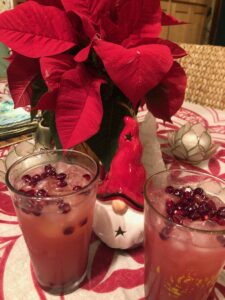 Happy Holidays to all of you, from all of us at Mariquita Farm!
Happy Holidays to all of you, from all of us at Mariquita Farm!
© 2020 Essay and Photos by Andy Griffin.
Mysteries
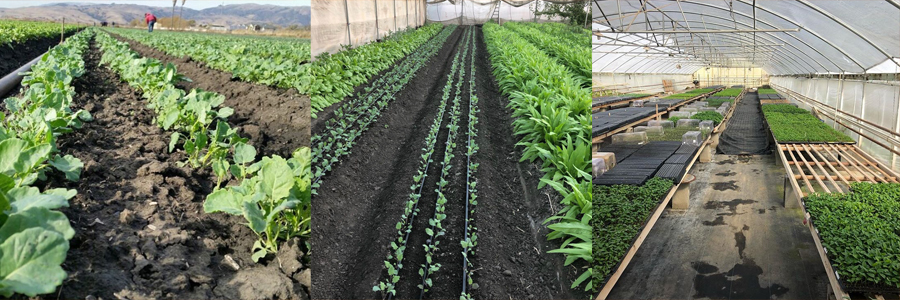
Hi Everybody: For years now we’ve called the mixed produce boxes that we have been packing and selling as “mystery boxes.” So, why?
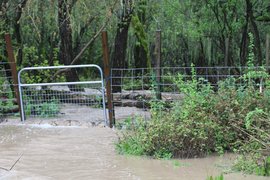
Flooding circa 1997
It’s an inside joke, I guess; sometimes it’s a “mystery” to me as to how we’ll get the produce harvested, packed, and delivered on time. A lot of things can happen between the time I give Shelley the list of what I intend/hope to put in the box and the moment that the cartons are opened and emptied by the home cooks. We strive to deliver value to our supporters in every box, but sometimes nailing an explicit list made days in advance down to the last letter and leaf can be challenging. Maybe I made a mistake when I looked at the fields and calculated the yields and we came up short on a promised item. Or maybe a sudden freeze, rainstorm, heat wave, or hail storm ruined the produce I’d planned on picking, and I have to improvise. Or maybe there’s a power outage the day of the pick and we can’t pump water to wash muddy produce or water the crops that are still in the ground….and it’s really hot. Or the field conditions are optimal but, since we don’t have a big crew, if somebody gets sick and can’t work we’re short-handed. Or somebody’s child has to go home from school and the parent can’t stay at work because they can’t find child care at the last minute, so we end up one person short. And, because all of our people ride share, if a driver has an issue we may lose the entire car load of workers who no longer have a way to get to work. There are a lot of potential issues that can unfold during a busy day that affect the composition of the final box. But sometimes all the stars line up and everything gets harvested just as I planned- today is one of those days- and the only mysteries remaining are for the people who receive the harvest box and ask themselves, “what is this? What do I do?” Here are some thoughts in case you’re mystified.
1. Little Gem lettuce: They make great salad lettuces but Gems can also be cooked too. See “Chinese Lettuce” below.
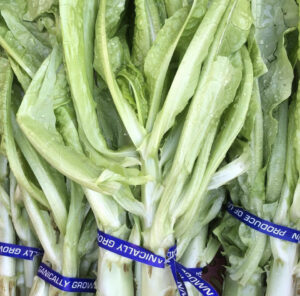
Chinese Lettuce aka Celtuce
2. “Celtuce” aka Chinese Lettuce: The Chinese appreciate the stems on their lettuce because they can be chopped into coins and stir fried. The leaves can be cooked as well, but also serve well in salads.
3. Italian Parsley: I like to pick parsley with long stems. Parsley is a close cousin to celery. If you look at the parsley stem and imagine it to be vastly fatter you can see the family resemblance. Sure, parsley leaves are fine for salads and seasoning, but the minced stems have lots of flavor and can sub for celery in many dishes.
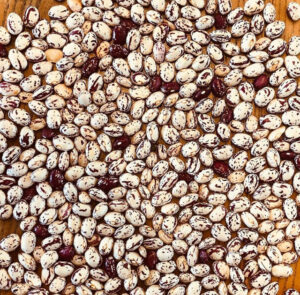
Tongue of Fire Beans
4. Beans: Whatever kind you get this week, be they Cranberry, or White or Scarlet runner beans, remember that these beans are very fresh and won’t take nearly as long to cook as the dried beans from the supermarket, which can be quite old by the time you buy them. There is no need to soak these beans overnight. I learned to just boil the beans until tender in unsalted water, then add any seasonings you might want later. For me, a pat of salted butter and some black pepper is enough for a satisfying bowl of beans. Easy!
5. French Breakfast radishes: Radishes for breakfast? I don’t know about that, but they’re great raw or cooked like baby turnips. Cook the radish greens or use in salads.
6. Meyer Lemons: Yes, Meyer lemons are sweeter than Eureka or Lisbon lemons, but don’t forget that half the flavor is in the peel, not the juice. I’ve been making simple syrups by cooking the zested rinds with sugar water. The lemon infused simple syrup is great for lemonade or limoncello. Lemon zest can jazz up shortbread cookies too. I use lemon juice instead of vinegar in many of the salads that I make.

Pomegranate Cocktail (Photo by Starling Linden)
7. Pomegranates: Yes, pomegranates are loaded with antioxidants, so they make a healthy addition to salads or to eat out of hand, but they can also be juiced to make a killer cocktail when antioxidants sound boring. We garnish guacamole with pomegranate seeds too, and they can be a nice surprise in a green salad.
8. Winter Squash: Some of you may receive a “Doran” squash, which is a small, round Butternut variety, and some of you may receive a Napolitano squash, which is a larger, longer Butternut type. Either way, these squash make great pies, soups, and roasted dishes, and they can be stored for a year if kept in a cool, dry place. Both of these squash types are open pollinated, heirloom crops, so if you’re a gardener you can save the seeds from the ones you receive and plant them next year.
9. Red Beets: Beets are great, but too many people forget that the greens are as good as chard. In fact, beets are the SAME PLANT as chard- Beta vulgaris- beets just have fat roots. The beets would be nice roasted with the French Breakfast radishes, the round carrots, and any potatoes you have lying around.
10. Round Carrots : These small, round, sweet carrots eat well out of hand, but their shape helps them roast well, and they’re also good for blowing little kids’ minds, because their shape is surprising.
11. Spigariello: This kale cousin is actually better at being kale than most varieties of kale are; the leaves are tender, cook fast in the wok or pot and they make a nice layering leaf in a veggie lasagna. The plant is Brassica oleracea- exactly the same as kale- so it can honestly be used to make a kale salad that is better than kale salad.
12. Arugula: Yes, arugula is good for salads and pesto dishes, but this mustard green marries well with the Peanut based sauces that show up in Thai food.
One of the big mysteries remaining for me is “how mild and negotiable is this winter weather going to be?” I’ll find out in the fullness of time. For now we’re planting like there are going to be no problems. Spinach is sizing up, cauliflowers are buttoning up inside their big floppy leaves, the broccoli is thinking about heading up and green garlic is almost ready to plant. Thanks, Andy
© 2020 Essay and Photos by Andy Griffin.
